Journal of Horticulture
Open Access
ISSN: 2376-0354
ISSN: 2376-0354
Research Article - (2023)Volume 10, Issue 1
Background and objectives: This research was conducted to investigate the effect of foliar application of different levels of salicylic acid and jasmonic acid on the morphological, physiological, and biochemical characteristics of garden thyme under water deficit stress conditions with evaporation pans. This research was conducted as split factorial based on a randomized complete block design with three factors with three replications at the Varamin research field in during the 2019 crop year.
Method: The main treatment includes irrigation levels: Irrigation was applied after 60 mm and 110 mm of evaporation from the class A evaporation pan, respectively, as normal irrigation and water deficit stress. And the sub factor includes foliar application treatment with different levels of salicylic acid and jasmonic acid was performed as factorial in random complete block design with three replications. Foliar application levels of salicylic acid at three levels: Control (zero), 25 mg/lit, and 50 mg/lit. Foliar spraying levels of jasmonic acid at three levels: Control (zero), 1 mg/lit and 2 mg/lit.
Finding: The results showed that drought stress had a significant decrease in plant height, fresh and dry weight yield components, chlorophyll a, b, and total chlorophyll content, and increased the amount of proline. Also, the interaction of the foliar application with different levels of salicylic acid and jasmonic acid reduced the destructive effects of drought stress and increased the tolerance of garden thyme medicinal plant. The highest and lowest plant heights, dry weight of shoot, and total chlorophyll were obtained from the treatments of (S0*SA2*JA2) and (S1*SA0*JA0), respectively. The comparison table of the average of the three effects showed that a significant difference was obtained from treatments of the highest and lowest percentage of shoot essential oil, proline and Ec observed (S1*SA2*JA2) and (S0*SA1*JA0), respectively.
Conclusion: In fact, it can be said that these substances indirectly reduced the activity of these enzymes and improved plant growth conditions.
Drought stress; Foliar application; Salicylic acid; Jasmonic acid; Proline; Garden thyme
S0: Normal irrigation; S1: The pressure of 110 ml of evaporation from the evaporation pan; SA0: No consumption Salicylic Acid; SA1: 25 mg/L Salicylic Acid; SA2: 50 mg/L Salicylic Acid; JA0: No use Jasmonic Acid; JA1: 1 mg/L Jasmonic Acid; JA2: 2 mg/liter Jasmonic Acid; %: Percent; ANOVA: Analysis of Variance; Chl: Total Chlorophyll; Ec: Electrical conductivity; Mg/g: Milligrams per gram; μmos/cm: Milli mos per centimeter; Mg/lit: Milligrams per liter; Kg/ha: Kilograms per hector; ns: not significant
The growing tendency to use medicinal plants and herbal medicines in the world attracted special attention to these plants. Even today, according to the world health organization, 25% of common medicines are of herbal origin. Garden thyme (Thymus vulgaris L.) is a member of the mint family and its aerial parts (leaves and flowers) constitute the medicinal part of this plant. Usually, the main phenolic compound of different thyme species is thymol and carvacrol, which are present in the form of glucoside and galactoside in essential oil. Today, thyme is used in the production of medicines for the treatment of asthma, bronchitis, gastrointestinal problems, joints, and control of seizures and nervous problems. The high number of phenolic compounds in this plant has caused it to have strong anti-microbial, anti-fungal, anti-bacterial, and anti-parasitic properties and it is used for disinfection. Water deficit stress can prevent or stop one or more physiological activities such as transpiration, photosynthesis, tissue and organ elongation, or cell enzyme activities. Plant growth regulators are used in all aspects of the plant's life cycle [1-3]. So that these substances can have a deep effect on the plant's reactions. Increasing the tolerance of plants is possible in different ways, such as using growth regulators. Growth regulators increase photosynthetic capacity and ultimately increase biological yield. These hormones were defined their key role as synergistic or antagonistic in adapting to environmental stress. Among these substances, salicylic acid and jasmonic acid can be mentioned. The researchers reported that water deficit stress decreased the dry weight of the roots and shoots and the amount of total chlorophyll and carotenoid of garden thyme was compared to the control. While the root length and the amount of proline were increased. Photosynthetic pigments and shoot length are important parameters related to yield (shoot dry weight) that can be useful in the improvement of thyme with high yield and effective substance as the main goal in the improvement of medicinal plants. The results showed that the concentration of chlorophyll decreased under drought stress compared to the control and reported thymol percentage and proline content were increased in the thyme plant. In the conditions of water deficit stress, changes in the yield of the essential oil and its compounds are caused by the activity of enzymes and the improvement of metabolism. With the decrease in water potential, the amount of proline in thyme leaves increased significantly. Which was similar to the results? Which was similar to the results of Lazcano-Ferrat and Lovatt? When plants are affected by drought, salinity, low temperatures, and other factors that reduce the water potential of cell sap. They should increase the concentration of their osmolytes to continue absorbing water under stress conditions among organic osmolytes, probably the most abundant and common compatible solute is proline which accumulates. The use of salicylic acid increased tolerance to abiotic stresses such as drought and salinity stress. The researchers reported that the concentration of 10 M-5 M salicylic acid increases the fresh and dry weight of the plant and the amount of the product in the mustard plant. Phenolic compounds have interfered in the transfer of materials to the source. It also prevents the oxidation of auxin and thus can affect growth. The research showed that the grain yield and harvest index in two medicinal plants basil and marjoram increased under the influence of salicylic acid. The use of salicylic acid improved the quality of the thyme and reduced hyper hydricity in the micro samples by reducing the amount of RWC in the plant. Jasmonates have a protective role. And its derivatives such as methyl jasmonate are internal growth regulators or plant growth inhibitors that play a key role in growth and development and response to environmental stresses. Jasmonates were introduced as key messenger compounds in the induction process leading to the accumulation of secondary metabolites. Jasmonic acid increased tolerance to water deficit stress with chlorophyll accumulation and net photosynthesis rate. The application of jasmonic acid causes the activity of ascorbate peroxidase and glutathione reductase) and antioxidant enzyme systems (superoxide dismutase, peroxidase, catalase, non-enzymatic (proline and soluble sugars) and decreases lipid peroxidation (malondialdehyde and hydrogen peroxide). Also were increased the Relative Water Content of the leaf (RWC) and the level of internal abscisic acid under water deficit stress conditions. Different concentrations of jasmonic acid have significant effects on the number of main compounds of Denai thyme; So that different concentrations were used to decrease or increase the number of secondary compounds [4,5]. By using a concentration of 100 micromoles of jasmonic, was observed a significant difference between the amount of thymol and carvacrol. There were observed between foliar spraying jasmonic acid treatments a significant difference in carotenoid and polyphenol content at 1% level and total flavonoid content at 5% level. Foliar application with 100 microliters of jasmonic acid had an effective on the number of compounds as well as the anti-oxidant property by the DPPH method in squeezed juice marigolds. Growth regulators increased photosynthetic capacity and biological yield. In other research, it has been reported that biological yield increases with the growth regulators of salicylic and jasmonic acid. This research was conducted by investigating the effect of foliar application of different levels of salicylic and jasmonic acid on some quantitative and qualitative characteristics of garden thyme under water stress conditions with evaporation pans in a farm in the Varamin region [6-8].
This research was conducted to investigate the effect of foliar application of different levels of salicylic acid and jasmonic acid on the morphological, physiological, and biochemical characteristics of garden thyme under water deficit stress conditions with evaporation pans. This research was conducted as split factorial based on a randomized complete block design with three factors with three replications at the varamin research field in the farming year 2019. The main treatment includes irrigation levels: Irrigation was applied after 60 mm and 110 mm of evaporation from the class A evaporation pan, respectively, as normal irrigation and water deficit stress. And the sub factor includes foliar application treatment with different levels of salicylic acid and jasmonic acid was performed as factorial in random complete block design with three replications. Foliar application levels of salicylic acid at three levels: Control (zero), 25 mg/liter, and 50 mg/liter. Foliar spraying levels of jasmonic acid at three levels: Control (zero), 1 mg/liter and 2 mg/liter. The foliar application was applied to all plants in the early morning before sunrise in the two stages of mid-vegetative growth and the beginning of flowering. The control treatments were applications with water. Each replication included 18 treatments and each treatment included 6 planting lines with a length of 4 meters, the distance between planting rows was 50 cm, the distance between two treatments was 0.5 meters, the distance between two repetitions was 1 meter, and the distance on the row was 15 cm. The planting operation was done manually method and in the form of dry work, it was planted half a centimeter deep in the middle of May. The studied traits were measured from sampling lines and after removing the marginal effects, in the middle of the flowering stage. Plant height was calculated in centimeters from the fourth and fifth lines (sampling lines) at the beginning of the flowering stage. To calculate the dry weight, the samples were dried in an oven at 60 degrees celsius for 24 hours and then weighed. The amount of total chlorophyll was measured by the method of Cholvadova, et al. Leaf proline was measured using a spectrophotometer at a wavelength of 515 nm. After applying each stress stage, the cell conductivity was measured by preparing a disc from the leaf of each treatment and placing it in distilled water for 8 hours, and finally measuring the Ec of the remaining solution. The amount of essential oil was measured as a percentage by weight, and the essential oils were kept in the freezer until the time of decomposition [7-10]. The type of essential oil was measured with a GC/MC mass spectrometer and the analysis of the essential oil and the identification of the type and number of compounds was done by thermal programming with the Adams method. The amount of jasmonic acid in leaves was determined by the FT-ICR mass spectrometry method in the laboratory.
At the end of the experiment, the results of each treatment after extension to hectare became variance analysis by MSTAT-C computer software, and the comparison of the average data was performed by Duncan's multiple-range test at the levels of 1%and 5% and the diagrams were drawn by the computer program of Excel software.
The results of the analysis of variance showed that plant height, dry weight shoot, total chlorophyll, leaf proline, leaf electrical conductivity, essential oil shoot, thymol percentage, and jasmonic acid content in leaves were influenced by the simple effects of water deficit stress, salicylic acid and jasmonic acid and the Interaction effects of salicylic acid*jasmonic acid, water deficit stress *salicylic acid, water deficit stress*jasmonic acid and the triple effects of water deficit stress*salicylic acid*jasmonic acid. The differences were statistically significant at the level of one and five percent (Tables 1 and 2).
| S.O.V | df | Plant height | Dry weight of shoot | Total chlorophyll |
|---|---|---|---|---|
| Replication | 2 | 44.31ns | 54129.6ns | 2.092ns |
| Water deficit stress | 1 | 52.03* | 184223.1* | 9.741* |
| Error A | 2 | 21.24 | 27036.7 | 1.506 |
| Salsilic acid | 2 | 2587.02* | 287649.1* | 16.893* |
| Jasmonic acid | 2 | 695.1* | 7435912.3** | 15.413* |
| Salsilic*Jasmonic acid | 4 | 659.3* | 9524638.6** | 49.052** |
| Stress*Salsilic acid | 2 | 2581.2** | 8726491.1** | 68.926** |
| Stress*Jasmonic acid | 2 | 672.4* | 10529673.3** | 51.720** |
| Stress*Salsilic*Jasmonic acid | 4 | 3278.1** | 9872861.5** | 64.309** |
| Error B | 32 | 114.19 | 42136.7 | 2.374 |
| C.v | 9.6 | 10.28 | 5.12 | |
| ns,*and **are not significant, significant at 1% and 5% probability level respectively. | ||||
Table 1: Variance analysis of plant height, shoot fresh weight and shoot dry weight of garden thyme plant under the effect of drought stress and foliar spraying of jasmonic acid and salicylic acid.
Plant height
The results of the comparison of the triple effects of stress*salicylic acid*jasmonic acid showed that the highest and lowest plant heights were obtained from the treatments of ((S0*SA2*JA2) with (32.3 cm)) and (S1*SA0*JA0) with (14.5 cm), respectively. A difference of 55% was observed between the highest and lowest treatments. No significant difference was observed between the treatments (S0*SA1*JA2), (S0*SA2*JA0) and (S0*SA2*JA1) and (S0*SA2*JA2) and they were all in statistical class A (Figure 1) [11-13].
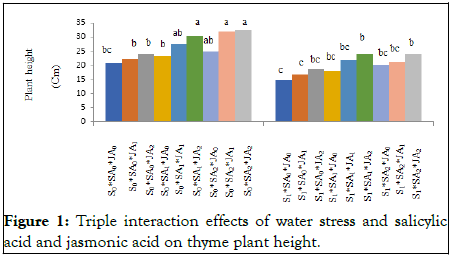
Figure 1: Triple interaction effects of water stress and salicylic acid and jasmonic acid on thyme plant height.
The height of the plant is considered one of the characteristics of growth. It indicates the number of nutrients made and stored during vegetative growth. The researchers stated that water deficit stress has a significant effect on the growth parameters and function of the vegetative organs of thyme. With increasing, water deficit stress, were reduced plant height, number of lateral stems, fresh and dry weight of aerial parts, root volume, fresh and dry weight of roots, and root length. Jasmonic acid regulates cell elongation and division along with other substances such as auxin. Increasing the rate of cell division of the terminal meristem of primary roots increases the longitudinal growth of the plant. It seems that drought stress has caused disturbances in mineral absorption. It reduces the absorption of water and minerals by interfering with the activity of transporters and ion channels in the root. And in this way, the amount of assimilates and vegetative growth and plant height is reduced. This is evident in this study. According to the role of jasmonic acid and salicylic acid during water deficit stress, they were able to increase some traits such as plant height, length, and internode number by improving the absorption of nutrients. The results of the comparison of the average of the three effects showed that by foliar application of salicylic acid and jasmonic acid, the negative effects of water deficit stress were reduced to a large extent and an increase of 55% was observed, which shows the positive effects of the anti-stress materials used in this research [14,15].
The dry weight of the shoot
The results of the comparison of the three effects of water deficit stress*salicylic acid*jasmonic acid showed that the difference of 73% between (S0*SA2*JA2) (1684.8 (Kg.ha)) and (S1*SA0*JA0) (441.9 (Kg.ha)) treatment, on the dry weight of shoots respectively (Figure 2). They were placed in the highest statistical class with the treatments S0*SA2*JA2, S0*SA1*JA2, and S0*SA2*JA1, and no significant difference was observed between these treatments. One of the first signs of water deficiency is the decrease in water pressure and as a result the decrease in cell growth and development, especially in the stem and leaves. As a result of water shortage stress, the production of photosynthetic materials decreases with the reduction of the leaf surface and the transfer of assimilated materials to the reproductive organs, which reduces the yield of flowering branches. For this reason, the first noticeable effect of lack of water on plants can be recognized from the smaller size of the leaves and the lower height of the plants. Researchers have reported dry matter production was decreased due to the cut irrigation in peppermint and tubular sage plants. Water deficit stress decreased the dry weight of the roots and shoots of garden thyme more than the control, but the root length was increased (Figure 2) [16,17].
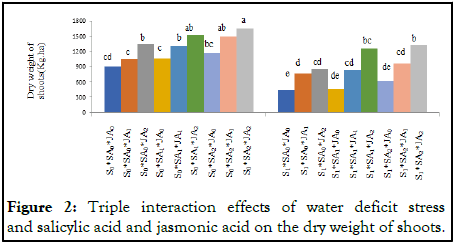
Figure 2: Triple interaction effects of water deficit stress and salicylic acid and jasmonic acid on the dry weight of shoots.
Salicylic acid can play a protective and defensive role in plants that are under environmental stress such as drought stress and increase the plant's tolerance against them. These findings explain the role of salicylic acid and jasmonic acid in the plant's response to living and non-living stresses, including heat stress and increased signaling and production of secondary plant metabolites [18,19]. By comparing the results of the water deficit stress treatment and the control as well as the foliar application of jasmonic acid and salicylic acid under stress conditions, an increase of 69% was observed, which indicates the important role of these substances in increasing the tolerance of thyme plants to drought. The use of these substances increases cell wall tolerance and stomatal conductance and photosynthesis efficiency and wet and dry yield in thyme under stress conditions.
Total chlorophyll
There is evidence that the plant's photosynthesis is reduced due to stress, by reducing the synthesis or destroying the pigments in the plant (chlorophyll and carotenoids). The highest and lowest total chlorophyll levels of the triple effects of the factors were observed in treatments (S0*SA2*JA2) with an average of 27.25 (mg.gFw) and treatment (S1*SA0*JA0) with an average of 10.09 (mg.gFw), respectively (Figure 3).
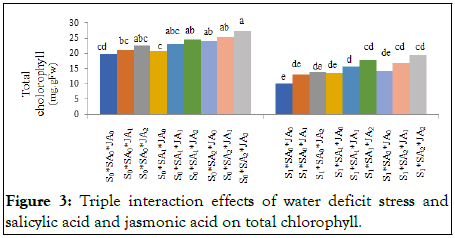
Figure 3: Triple interaction effects of water deficit stress and salicylic acid and jasmonic acid on total chlorophyll.
Salicylic acid with moderation in reducing the number of photosynthetic pigments and maintaining the structure and activity of rubisco increased the number of sugars. Fluorescence parameters and chlorophyll content are among the most important factors for determining the photosynthetic capacity during the life of plants. In this study, it was observed a significant decrease trend in all the pigments related to the stressed samples compared to the pre-stressed conditions. This decreasing trend can be considered as the reason for the loss of photosynthetic pigments biosynthetic enzymes and also the induction of decomposition or inhibition of their synthesis under stress conditions. Among these enzymes is the glutamate ligase enzyme, which plays an important role in the synthesis of chlorophyll. And the reduction of chlorophyll synthesis is due to inhibiting the activity of glutamate ligase enzyme in drought stress conditions [20].
Among other reasons, the decrease in the number of photosynthetic pigments under drought stress can generally be attributed to the destruction of the chloroplast structure and photosynthetic apparatus, photo oxidation of chlorophylls, their reaction with singlet oxygen, and hormonal disorders. The use of salicylic acid in drought stress conditions increased some physiological processes which can increase the tolerance of the plant against water deficit stress. The results of this research showed that the negative effects of drought stress were reduced by foliar application of salicylic acid and jasmonic acid. And in this research, it was observed 55% increase, which shows the positive effects of using anti-stress materials (Figure 3).
| M.s | ||||||
|---|---|---|---|---|---|---|
| S.O.V | df | Proline | EC | Percentage of thymol | Essential oil of shoots | Jasmonic acid |
| Replication | 2 | 217.39ns | 192.41ns | 0.0071ns | 0.00026ns | 0.0458ns |
| Water deficit stress | 1 | 659.32* | 518.63* | 0.0435* | 0.0021* | 0.1916* |
| Error A | 2 | 109.55 | 77.52 | 0.0064 | 0.00031 | 0.028 |
| Salsilic acid | 2 | 6941.27** | 341.18* | 0.0365* | 0.162* | 2.762** |
| Jasmonic acid | 2 | 5290.64** | 296.16* | 0.1847** | 0.273* | 1.893** |
| Salsilic*Jasmonic acid | 4 | 8541.34** | 925.42** | 0.3602** | 0.183* | 2.109** |
| stress*salsilic acid | 2 | 2209.86* | 1082.55** | 0.1872** | 0.244* | 2.764** |
| Stress*Jasmonic acid | 2 | 2197.40* | 1409.31** | 0.1593** | 0.198** | 3.101** |
| Stress*Salsilic *Jasmonic Acid | 4 | 9302.06** | 1264.17** | 0.2367** | 0.234** | 3.894** |
| Error B | 32 | 321.76 | 49.03 | 0.0053 | 0.0076 | 0.085 |
| C.v | 4.28 | 4.74 | 4.89 | 3.72 | 1.69 | |
Table 2: Variance analysis of leaf proline, leaf electrical conductivity, shoot essential oil, thymol percentage, and jasmonic acid content under the effect of drought stress and foliar spraying of jasmonic acid and salicylic acid.
Leaf proline
Proline is one of the most important amino acids that form the major part of many proteins involved in the regulation of osmosis, cell wall, and membrane. The results of the comparison of the triple effects of stress*salicylic acid*jasmonic acid showed a difference of 80% between the normal irrigation and 50 (mg. lit) salicylic acid and 2 (mg. lit) jasmonic acid (S0*SA2*JA2) (8.59 mg. gFw) and water deficit stress and control treatments ((S1*SA0*JA0) (43.21 mg.gFw)), respectively (Figure 4).
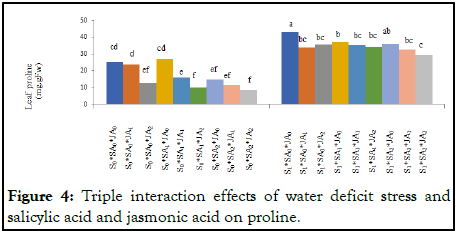
Figure 4: Triple interaction effects of water deficit stress and salicylic acid and jasmonic acid on proline.
Amino acids as osmotic regulators play a major role in plant metabolism. They will attend in reaction to non-living stresses. One of the osmotic regulators of environmental stresses is proline, which has a high correlation with stress tolerance in a large number of plant species.
The accumulation of proline in plants under stress is due to the synthesis of proline and its non-degradation. Increasing proline content protects cell membrane, proteins, and cytoplasmic enzymes and inhibits reactive oxygen species and removes free radicals in stress conditions; biosynthesis of proline is done from glutamic acid in the cytosol and chloroplast of plant cells under water shortage conditions. Therefore, proline accumulates in the cytosol to distribute water inside the cell. The use of salicylic and jasmonic acid in drought stress conditions showed a 46% decrease in proline. The use of salicylic acid increased some physiological processes and plant tolerance during drought stress. The application of salicylic acid in different concentrations was able to reduce the amount of proline assimilates produced under drought stress conditions to increase the wet and dry weight yield of thyme. Which is contrary to research? In fact, it can be said that the increase in photosynthetic pigments, proline, and sugars and the decrease in lipid peroxidation of the membrane indicates a decrease in oxidative damage and the role of salicylic acid in increasing stress tolerance which is evident in this research.
Electrical Conductivity (EC)
Under drought stress, the cell membrane loses its stability placing the leaf in a watery environment ooze dissolved substances from its cells. Therefore, the stability of the membrane is evaluated by the percolation of ions into the water. The triple effects of stress*salicylic acid*jasmonic acid showed that an 85% difference was observed between the normal irrigation and 50 (mg. lit) salicylic acid and 2 (mg. lit) jasmonic acid ((S0*SA2*JA2) (105.4 μmos. cm)) treatment and of water stress and without spraying salicylic acid and jasmonic acid ((S1*SA0*JA0) (734.6 μmos.cm)) treatment (Figure 5).
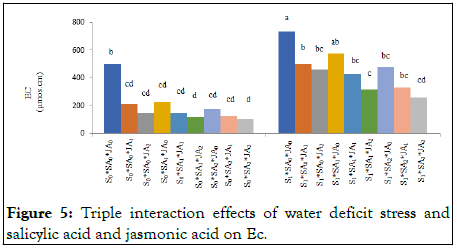
Figure 5: Triple interaction effects of water deficit stress and salicylic acid and jasmonic acid on Ec.
It seems that Electrical conductivity (Ec) is related to the synthesis of heat shock proteins and the characteristics of the photosynthetic system, including enzymes and thylakoid membranes under stress conditions. The results showed that an increase in the intensity and duration of drought stress causes a more severe disturbance in the biological activities of the cell membrane, a decrease in its fluidity and the rate of pumping of membrane ions, and increases the amount of ion leakage, In this research, changes in the cell membrane structure were observed due to changes in lipids and other factors with ion leakage in drought stress conditions. It seeped out by destroying the cell membrane to the outside of the cell contents. It seems to be protected by using salicylic acid and jasmonic acid cell membranes from stress-induced damage by inducing antioxidant responses. Researchers believe that when salicylic acid is used at the right concentration and time, it causes temporary oxidative stress in plant cells, which acts as a resistance process (hardening and increases the antioxidant capacity of the cell. The research results showed that the use of salicylic acid reduced ion leakage in cucumber and tomato seedlings, which is consistent with the results of this research.
The percentage of shoot essential oil
Thyme essential oil is one of the ten famous essential oils. Among the medicinal uses of the essential oil of this plant, we can refer to stomach strengthening, anticonvulsants, anti-spasm, rheumatism, skin disorders, phlegm, and cold treatment.
The comparison table of the average of the three effects showed that a significant difference was obtained from treatments of the highest and lowest percentage of shoot essential oil in drought stress and 50 (mg. lit) salicylic acid and 2 (mg. lit) jasmonic acid ((S1*SA2*JA2), (0.483%)) and normal irrigation and control ((S0*SA1*JA0) (0.115%)), respectively (Figure 6).
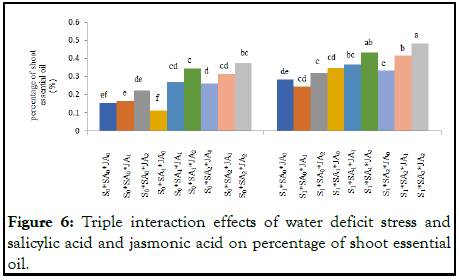
Figure 6: Triple interaction effects of water deficit stress and salicylic acid and jasmonic acid on percentage of shoot essential oil.
Thyme contains compounds such as flavonoid, saponin, and bitter substances, and the majority of thyme essential oil consists of phenols, monoterpene hydrocarbons, and alcohols. The researchers found that by studying the thymus pulegioides plant the highest amount of essential oil is at the flowering stage of this plant. Shortage of water has a significant effect on the growth, fatty acids, essential oil yield, and compositions of Maryam Galli so the medium tension increased the yield of the essential oil (in 100 grams of dry matter) There was an increase in the average stress The main compounds of essential oil, including camphor, alphatogen and 8,1-cineol in the medium stress.
In medicinal plants, drought stress may have a significant effect on the yield of some metabolites and compounds. In this research, drought caused an increase in secondary metabolites (essential oils) that have a protective effect against stresses. In this research, drought stress caused an increase in secondary metabolites (essential oils) that have a protective effect against stress. In this research, salicylic acid and jasmonic acid increased the amount of essential oil in garden thyme by neutralizing free radicals and active forms of oxygen produced in drought stress which is consistent with the research.
The percentage of thymol
Thymol is the most important part of the essential oil of the thyme plant and is economically significant. The results of the triple effects of stress*salicylic acid*jasmonic acid showed that a 12% difference was observed between the highest and lowest percentage of thymol levels, between (S1*SA2*JA2) (69.8%) and (S0*SA1*JA0) (57.9%) treatments, respectively (Figure 7).
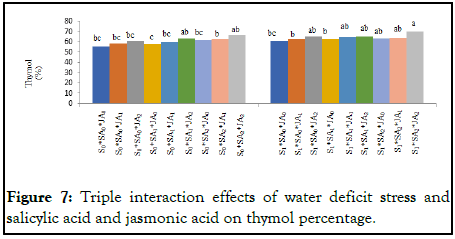
Figure 7: Triple interaction effects of water deficit stress and salicylic acid and jasmonic acid on thymol percentage.
The gene limonene 3-hydroxylase was encoding the limonene hydroxylase enzyme. And it is responsible for hydroxylating limonene, placing OH at carbon number 3 in the production and synthesis of monoterpenes in thyme. That will cause the breakdown of limonene into a wide range of secondary metabolite structures. Drought stress becomes a cause of the increase of secondary metabolites in the plant. According to the growth-development balance hypothesis, any deficiency limits growth more than photosynthesis. It increases the production and accumulation of secondary metabolites. It has a protective role, increasing secondary metabolites, and essential oil components. These compounds are used as non-antioxidant agents during stress. It is obvious in the research, increasing the amount of menthol and total sesquiterpenes in the thyme plant. The researchers reported it is caused by changes in the composition of essential oils from the activity of enzymes and improvement of metabolism in stressful conditions. It seems that foliar spraying with jasmonic acid increases or decreases some secondary metabolites, especially important phenolic compounds in thyme essential oil. The use of these substances in the thyme medicinal plant leads to changes in the amount of some important secondary compounds such as thymol, A significant difference was observed between the amount of thymol and carvacrol using a concentration of 100 micromoles of jasmonic acid, it is by the research Hamedi, et al.
Jasmonic acid in leaves
Jasmonic acid and its derivatives such as methyl jasmonate are internal growth regulators or plant growth inhibitors that play a key role in growth and development and response to environmental stresses. Based on the comparison table of the average of the three effects on the quality of jasmonic acid in the leaves, a difference of 66% was observed between (S1*SA2*JA2) (37.61 pmol.grfw) and (S0*SA1*JA0) (20.81 pmol.grfw) treatments, respectively (Figure 8).
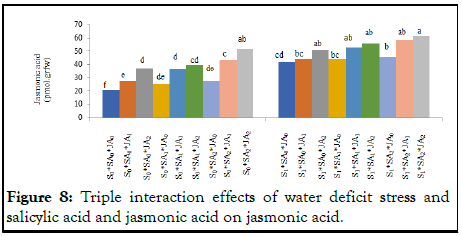
Figure 8: Triple interaction effects of water deficit stress and salicylic acid and jasmonic acid on jasmonic acid.
In this research, under drought stress, the application of jasmonic acid caused a significant increase in the content of jasmonic acid in leaves. This increase that happened increased the tolerance of the plant to drought by affecting the metabolic pathways of the plant. The results showed that the highest amount of jasmonic acid in leaves was obtained from treatment (S1*SA2*JA2), the reason can be seen in the adaptation of thyme to drought stress conditions.
The results showed there was decreasing plant height, wet weight, dry weight of aerial organs, essential oil percentage, and leaf chlorophyll content with increasing stress level, but it increased osmotic regulators (proline) and percentage of essential oil. Foliar application with jasmonic acid and salicylic caused a significant increase in plant height, dry and wet weight of aerial parts, thymol percentage, and essential oil percentage. We can conclude That the interaction of jasmonic acid and salicylic acid as an elicitor in garden thyme can in addition to reducing the negative effects of drought stress be influential on the quantity and quality of essential oil, according to the results of this research and taking into account the fact that the most important ingredients in garden thyme essential oil are related to menthol. Using a concentration of two milligrams per liter of jasmonic acid and 50 milligrams per liter of salicylic acid it was stimulating the biosynthetic pathway of the menthol compound and increased the yield of essential oil in the garden thyme plant. It can be said that foliar application with salicylic acid and jasmonic acid is one of the negative effects of drought stress and improves vegetative growth, and leaf chlorophyll it becomes Increases assimilates and yield of wet and dry weight and yield of essential oil. Therefore, can be suggested this level of salicylic acid and jasmonic acid under stress conditions for the tested area.
[Crossref] [Google Scholar] [PubMed]
[Crossref] [Google Scholar] [Pubmed]
[Crossref] [Google Scholar] [PubMed]
Citation: Karimi Z, Nasri M, Kasraei P, Oveysi M, Larijani HR (2023) Foliar Application of Jasmonic and Salicylic Acid on Garden Thyme under Drought Stress Conditions. J Hortic. 10:006
Received: 14-Jan-2023, Manuscript No. HORTICULTURE-23-21395; Editor assigned: 16-Jan-2023, Pre QC No. HORTICULTURE-23-21395 (PQ); Reviewed: 30-Jan-2023, QC No. HORTICULTURE-23-21395; Revised: 20-Apr-2023, Manuscript No. HORTICULTURE-23-21395 (R); Published: 27-Apr-2023 , DOI: 10.35248/2376-0354.23.10.006
Copyright: © 2023 Karimi Z, et al. This is an open-access article distributed under the terms of the Creative Commons Attribution License, which permits unrestricted use, distribution, and reproduction in any medium, provided the original author and source are credited.